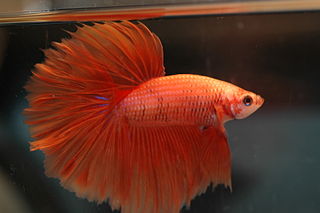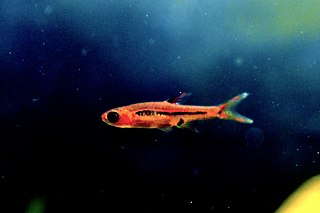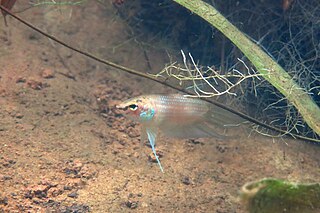
Gouramis, or gouramies, are a group of freshwater anabantiform fish that comprise the family Osphronemidae. The fish are native to Asia—from the Indian Subcontinent to Southeast Asia and northeasterly towards Korea. The name "gourami", of Indonesian origin, is also used for fish of the families Helostomatidae and Anabantidae.

The Siamese fighting fish, commonly known as the betta, is a freshwater fish native to Southeast Asia, namely Cambodia, Laos, Myanmar, Malaysia, Indonesia, Thailand, and Vietnam. It is one of 73 species of the genus Betta, but the only one eponymously called "betta", owing to its global popularity as a pet; Betta splendens are among the most popular aquarium fish in the world, due to their diverse and colorful morphology and relatively low maintenance.

The harlequin rasbora is a small fish in the family Cyprinidae. The species became an instant favorite among aquarists after its introduction in the early 1900s and is the best known and most widely kept species among the rasboras. In 1935, an image of a trio of harlequin rasboras, stamped in 14k gold, would grace the cover of the first edition of William T. Innes's classic Exotic Aquarium Fishes and would remain so through all 19 editions.

Bubble nests, also called foam nests, are created by some fish and frog species as floating masses of bubbles blown with an oral secretion, saliva bubbles, and occasionally aquatic plants. Fish that build and guard bubble nests are known as aphrophils. Aphrophils include gouramis and the synbranchid eel Monopterus alba in Asia, Microctenopoma (Anabantidae), Polycentropsis (Nandidae), and Hepsetus odoe in Africa, and callichthyines and the electric eel in South America. Most, if not all, fish that construct floating bubble nests live in tropical, oxygen-depleted standing waters. Osphronemidae, containing the Bettas and Gouramies, are the most commonly recognized family of bubble nest makers, though some members of that family mouthbrood instead. The nests are constructed as a place for fertilized eggs to be deposited while incubating and guarded by one or both parents until the fry hatch.
The spotted betta or Java fighting fish is a species of gourami endemic to Indonesia where it inhabits relatively cool, 22‒25 °C (72‒75 °F), highland streams of Java. In 1967, D. S. Johnson reported the species to be common in blackwaters of southern Malaya.

The eyespot rasbora is a small fish belonging to the Family Cyprinidae, subfamily Danioninae, which is known by the common names of ocellated rasbora, hi-spot rasbora, and eye-spot rasbora, an allusion to the marking situated upon the dorsal fin. This small fish is a popular aquarium fish, having been one of the species featured in the landmark textbook Exotic Aquarium Fishes by Dr William T. Innes. Its appearance in this work only occurs in later editions of the book, however, therefore the species is not subject to the same degree of aquarium domestication as the more familiar harlequin rasbora.
Betta miniopinna is a species of gourami endemic to Bintan Island in the Riau Archipelago of Indonesia. The species reaches 2.4 cm in standard length and is believed to be a facultative air-breather.

The Krabi mouth-brooding betta, Betta simplex, is a species of gourami endemic to Krabi Province, Thailand. It inhabits karst springs and wetlands, where it lives amongst vegetation close to the banks. This species can reach a length of 8 cm (3 in). This species can also be found in the aquarium trade and is taken from the wild for this purpose. The International Union for Conservation of Nature has assessed it as being "critically endangered" due to over-exploitation and the degradation of its restricted habitat by pollution and development of the surrounding land for farming.

Betta pallifina is a species of gourami endemic to the island of Borneo.

Betta is a large genus of small, active, often colorful, freshwater ray-finned fishes, in the gourami family (Osphronemidae). The best known Betta species is B. splendens, commonly known as the Siamese fighting fish and often kept as an aquarium pet.

The twospot rasbora is a species of ray-finned fish in the genus Rasbora native to south east asia. It is one of the members of the Sumatrana group.
The yellow rasbora is a species of ray-finned fish in the genus Rasbora from Southeast Asia. It is a primarily freshwater fish originally from Java island in Indonesia. It is known as the Wader pari fish in the Indonesian language. In addition, it was a protein source for the local community during the old days.

Rasbora sarawakensis, also known as the blue line rasbora or Sarawak rasbora, is a species of ray-finned fish in the genus Rasbora which is endemic to the island of Borneo.

Boraras brigittae is a species of ray-finned fish in the genus Boraras, also known as chili rasboras or mosquito rasboras, are a very small species of fishes native to the swamps of South West Borneo, Indonesia.

Betta ferox is a species of gourami endemic to Thailand. It is only found in rivers in Songkhla Province, where it resides along shallow riverbanks among vegetation. This species grows to a length of 6.3 centimetres (2.5 in) SL. This species is closely related to Betta pugnax and is also a paternal mouthbrooder. Males and females are dimorphic, with males displaying elongated ventral fins, elongated caudal fins, and green coloration on the gill plates. Females typically display two horizontal brown bars across their bodies, shorter fins, and a more rounded body shape.

The southern pygmy perch, also known as the Tasmanian pygmy perch, is a species of freshwater ray-finned fish, a temperate perch from the family Percichthyidae which is native to south-eastern Australia and Tasmania.
Betta compuncta is a species of ray-finned fish in the family Osphronemidae. It reaches 6.2 cm in standard length.
Betta pardalotos is a species of fish in the family Osphronemidae. It is native to Asia, where it occurs in the Musi River basin on the island of Sumatra in Indonesia. The species reaches 7.2 cm in standard length and is known to be a facultative air-breather. It feeds on insects and other small invertebrates such as zooplankton.
Betta dennisyongi is a species of gourami. It is native to Asia, where it occurs on the island of Sumatra in Indonesia, ranging from Meulaboh to Singkil. It is typically seen in lowland hillstreams and acidic swamps with clear to brown water, including farmland environments. It is known to occur alongside the species Kryptopterus piperatus, Mystus punctifer, Nemacheilus tuberigum, Ompok brevirictus, Osteochilus jeruk, Rasbora jacobsoni, and Rasbora kluetensis. The species reaches 3.5 cm in standard length and is known to be a facultative air-breather.












